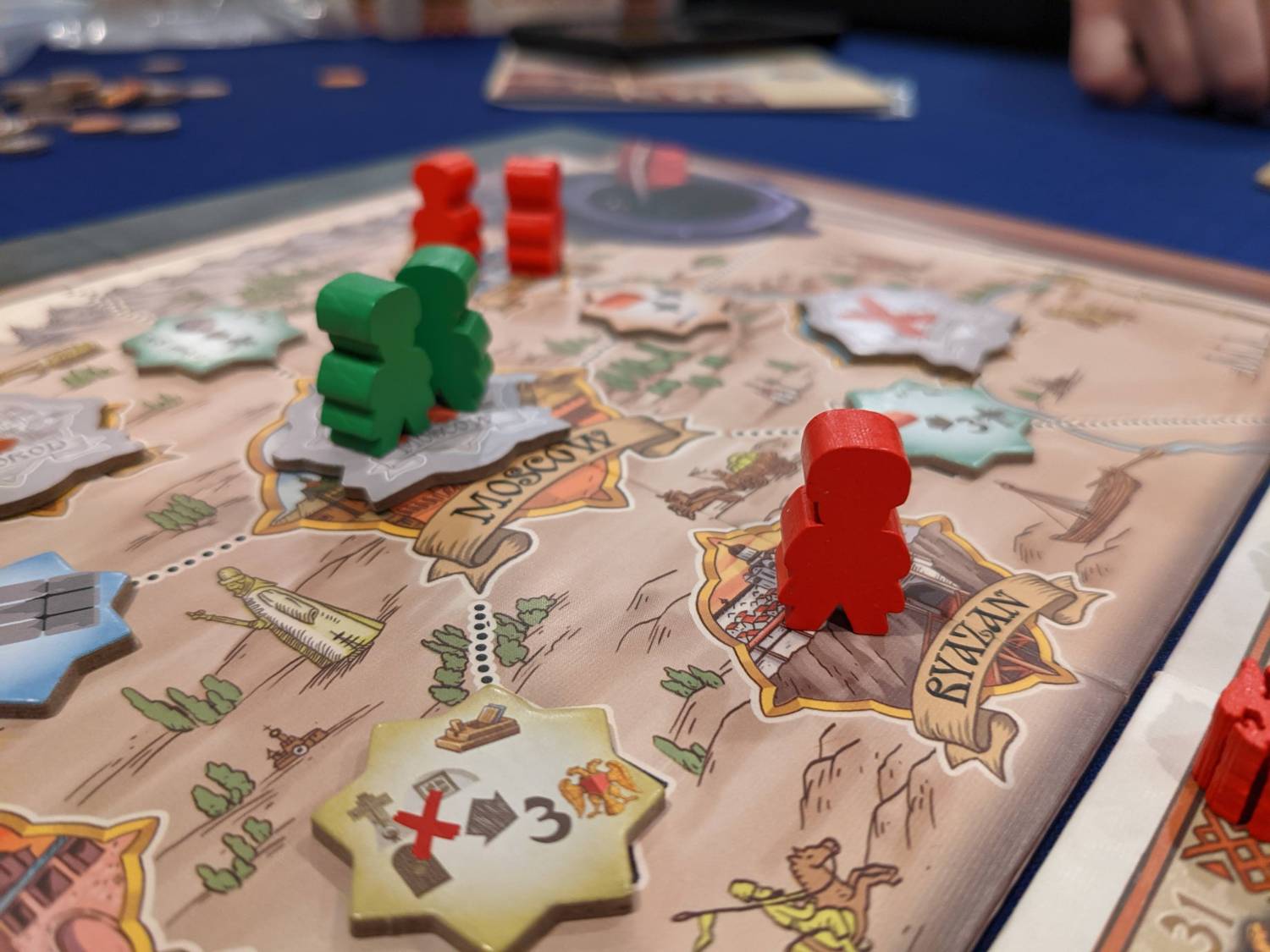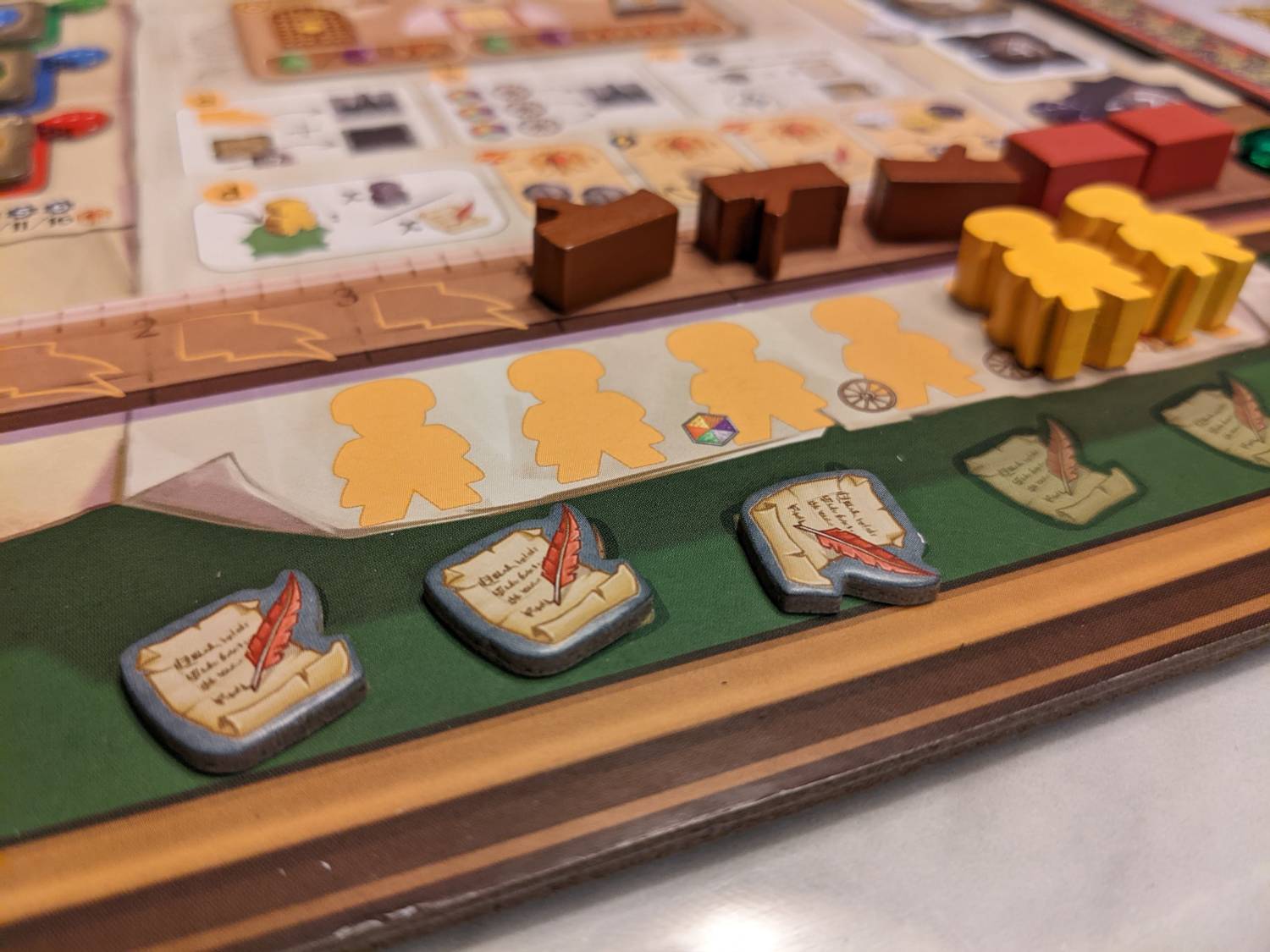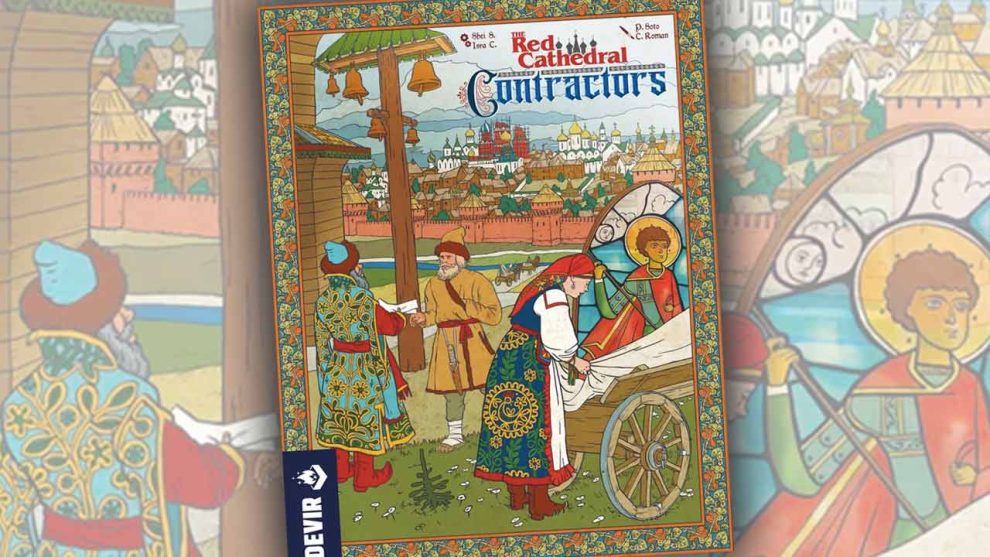Disclosure: Meeple Mountain received a free copy of this product in exchange for an honest, unbiased review. This review is not intended to be an endorsement.
The Red Cathedral (2020, Devir) is one of my all-time favorite games. I love the dice mechanic on the Market board, I love the efficiency puzzle of how to get resources into the cathedral to build sections and score points, and I love how much game $30 can get you in such a tidy box.
It was only a matter of time before expansion content came running our way, so to the surprise of no one, designers Shei Santos and Isra Cendrero are back with The Red Cathedral: Contractors. This expansion is NOT broken into modules, like other recent expansions I have played such as The Taverns of Tiefenthal: Open Doors.
However, there’s an opening to do just that—break the game into modules—by using one of the new elements here that can be used in both the base game and the expansion. I’m already sure I will be adding this one new option to the base game thanks to the only major mistake Contractors makes: the box.

More Board
Contractors introduces a fourth action to each player’s turn: Hiring. This action allows players to add meeples known as Contractors to a separate area known as the Grand Duchy of Moscow board. Here, players can add one of their six Contractors to a map broken into sections by paying Permits—a new resource in Contractors—and then hiring Specialists, a new tile type that can be used to activate minor one-time powers before residing at the side of your board for end-game set collection scoring.
There’s also a new black six-sided die added to the pool of the five other dice used in each game. This die has the same movement magic as the others used on the Market board: move the die a number of pips showing on the die face to a resource space, take what’s there multiplied by the number of dice already there, reroll all the dice for the next player. To use your Specialist tiles, you have to activate that black die, similar to how the Workshop tiles are used for moving the other dice.
Placing your Contractors on the map may trigger one-time bonuses, but they also grant the ability to score City Points. These City Points activate when a column of sections in the Cathedral are all completed, using some simple math: number of your Contractors in a zone multiplied by the number of banners you have in the completed column of the Cathedral. During setup with the expansion, each Cathedral section is now topped with a signpost of which city section will score when it is completed, so everyone knows when scoring will take place.
However, these points are Recognition Points, not Prestige Points. This means that the scoring in the Grand Duchy of Moscow section can be quite minor unless you steer many of your six Contractors into a section of the Cathedral where you have the majority of your banners. Otherwise, you’ll do what I’ve seen in most of my games, score just a couple of Recognition Points. (These are the minor points that you get in the first game, not the large sectional moves you get with Prestige Points, which my friends call “Iron Eagle Points” because early in the game, they are bigger jumps up the scoring track.)

A Little More Weight
The expansion adds a little something to the proceedings, but it distracts from the goal: you are still trying to build your sixth section of the Cathedral first, triggering the end game. This also means the majority of your scoring will still come from the area control scoring that takes place in each tower of the Cathedral.
The exception to that is if you somehow nail the set collection element of Specialist scoring tiles. If you grab a full set of all six different symbols on those tiles, you’ll score a whopping 16 Prestige Points. (For perspective, 50 Prestige Points is a good score in the base game.) You’ll still score for sets of unique symbols, but at a much lower point count; so far, I have only been able to grab four Specialist tiles total in a game because I’m only doing the Hiring action a few times each game.
16 Prestige Points is the best you’ll ever be able to do, because you can only grab six of those tiles in a game thanks to your six Contractors. I still haven’t seen this happen, and I’m having a very difficult time imagining this scenario EVER happening. It takes too many actions, and doesn’t score enough points quickly to keep up with players bent on building the Cathedral.
Where Contractors really shines, though, is with the new Guilds.

The Guilds, Baby
The base game was lacking when it came to the variability of the Guild cards. Residing at each corner of the Market board., these are the cards that grant a minor ability after resolving the dice action of the quadrant where you placed a die.
There were only three cards per Guild available in the base game. That part was fine, but there were only four Guilds in the game. Contractors adds a whopping TEN new Guilds to the proceedings, randomly drawn at setup.
Gamechanger.
Some of the Guilds do more interesting things with the base game’s resources, such as the Bricklayers Guild. Some do new things that can be used in both the base game and Contractors, such as the Jewelers, which add Diamonds to the resource pool—Diamonds which can take the place of any other resource. Just two of the Guilds can only be used in the expansion, meaning that if you only use these new Guilds with the base game, you’ve got 12 Guilds to choose from.

Come for the New Guilds, Stay for the Base Game
The Grand Duchy of Moscow board adds a minor twist to an already solid base game experience, but not enough to tote around two boxes of The Red Cathedral.
Ahh, yes; I promised to tell you about the box.
Contractors adds just enough stuff to the game that you can’t get it all into one box. As a guy struggling with shelf space already, fans of expansions should take note: buying Contractors and using all the stuff regularly means you will need to keep both game boxes.
This is criminal. This is partially the fault of the base game, jamming so much stuff into such a small box. Adding expansion content almost guaranteed there would be trouble.
But not if you stick to my recommendations: You can easily get the new Guild cards into the base game box (36 small cards), plus the six new setup cards used to design the tower. (Those new cards don’t add anything special, but you’ve got the space for them.) You’ll need a few more cards plus the Diamonds, but otherwise, you can get all of this into a single box.
Discard all four of the extra instruction manuals in the languages you don’t need. That’s eight manuals across both games. You can dump the solo cards, too; sadly, Contractors against the automa remains disappointing, like the below-average solo available with the base game.
The expansion board, black die, Contractor meeples and the Hiring action don’t add enough magic for me, so leave all of that behind. That’s OK—the base game is so good that I don’t need the extras. But, I love the variety added into the package with the new Guilds, and the game still fits comfortably in a travel carry-on.
Note that you can only use one expansion Guild in any single game of Contractors; to ensure balanced trading actions, three of the four base game Guilds will always be in play. No sweat. That just means it will take me longer to see all the new stuff. I pull out The Red Cathedral maybe once a quarter, and now the game will feel fresh again thanks to the Guilds!












Add Comment